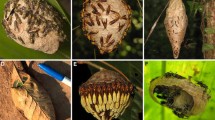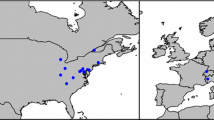Abstract
Success of an invasive organism depends on the level of biotic resistance from native species. Understanding the mechanism of biotic resistance is critical to the management of invasive species, but such case studies are sparse. Native to parts of Asia and Russia, the red-necked longhorn beetle Aromia bungii (Faldermann) (Coleoptera: Cerambycidae) recently invaded Germany, Italy, and Japan, causing serious damage to Rosaceae trees. To identify any specific mechanism of biotic resistance to A. bungii, we investigated whether Japanese native ants play a role in the biotic resistance through predation, because ants can impact many arthropods as generalist predators. In laboratory experiments, A. bungii eggs or hatchlings were offered to four ant species. Three species exhibited predatory behaviors toward the eggs within 30 min, and obvious damage was confirmed on the eggs within 2 days. Two ant species fatally damaged hatchlings within 30 min. In field surveys, we found a negative correlation between the number of A. bungii frass-ejection holes and the number of collected ants on tree trunks. These results suggested that Japanese native ant fauna can play a certain role in biotic resistance to A. bungii.


Similar content being viewed by others
References
Aluja M, Birke A, Ceymann M, Guillén L, Arrigoni E, Baumgartner D, Pascacio-Villafán C, Samietz J (2014) Agroecosystem resilience to an invasive insect species that could expand its geographical range in response to global climate change. Agric Ecosyst Environ 186:54–63. https://doi.org/10.1016/j.agee.2014.01.017
Brockerhoff EG, Liebhold AM (2017) Ecology of forest insect invasions. Biol Invasions 19:3141–3159. https://doi.org/10.1007/s10530-017-1514-1
Elton CS (1958) The ecology of invasions by animals and plants. Methuen, London. https://doi.org/10.1007/978-1-4899-7214-9
Hanks LM, McCelfresh JM, Millar JG, Paine TD (1992) Control of the straw itch mite (Acari: Pyemotidae) with sulfur in an insect rearing facility. J Econ Entomol 85:683–686. https://doi.org/10.1093/jee/85.3.683
Harada Y, Haruguchi S, Iwasaki T, Onishi K, Tashiro Y, Yamane S (2010) Ants from Jananese cherry trees, Prunus × yedoensis, in public parks in Kagoshima, southwestern Japan. Bull Biogeogr Soc Jpn 65:169–179 (in Japanese with English abstract)
Hayashi M, Nakamuta K, Nomura M (2015) Ants learn aphid species as mutualistic partners: Is the learning behavior species-specific? J Chem Ecol 41:1148–1154. https://doi.org/10.1007/s10886-015-0651-1
Hopper JV, Mills NJ (2016) Novel multitrophic interactions among an exotic, generalist herbivore, its host plants and resident enemies in California. Oecologia 182:1117–1128. https://doi.org/10.1007/s00442-016-3722-2
Hölldobler B, Wilson EO (1990) The ants. The Belknap Press of Harvard University Press, Cambridge
Iwata R (2018) Aromia bungii (Coleoptera: Cerambycidae): Taxonomy, distribution, biology and eradication. For Pests 67:7–34 (in Japanese)
Kenis M, Hilszczanski J (2007) Natural enemies of Cerambycidae and Buprestidae infesting living trees. In: Lieutier F, Day FR, Battisti A, Gregoire J-C, Evans HF (eds) Bark and wood boring insects in living trees in Europe, a synthesis. Springer, Dordrecht, pp 475–798. https://doi.org/10.1007/978-1-4020-2241-8_21
Levine JM, D’Antonio CM (1999) Elton revisited: a review of evidence linking diversity and invasibility. Oikos 87:15–26. https://doi.org/10.2307/3546992
Levine JM, Adler PB, Yelenik SG (2004) A meta-analysis of biotic resistance to exotic plant invasions. Ecol Lett 7:975–989. https://doi.org/10.1111/j.1461-0248.2004.00657.x
Men J, Zhao B, Cao DD, Wang WC, Wei JR (2019) Evaluating host location in three native Sclerodermus species and their ability to cause mortality in the wood borer Aromia bungii (Coleoptera: Cerambycidae) in laboratory. Biol Control 134:95–102. https://doi.org/10.1016/j.biocontrol.2019.04.007
Muilenburg VL, Goggin FL, Hebert SL, Jia LL, Stephen FM (2008) Ant predation on red oak borer confirmed by field observation and molecular gut-content analysis. Agric For Entomol 10:205–213. https://doi.org/10.1111/j.1461-9563.2008.00371.x
Nakamura A, Abé H, Iwata R (2017) Arboreal ants at isolated small stands in Fujisawa City, Kanagawa Prefecture. Nat Hist Rep Kanagawa 38:41–48 (in Japanese with English abstract)
Ochi K, Katagiri K (1979) Mortality factors in survival curves of Monochamus alternatus Hope (Coleoptera: Cerambycidae) population on the pine dead trees. Bull For For Prod Res Inst 303:125–152 (in Japanese with English abstract)
Paine TD, Millar JG, Paine EO, Hanks LM (2001) Influence of host log age and refuge from natural enemies on colonization and survival of Phoracantha semipunctata. Entomol Exp Appl 98:157–163. https://doi.org/10.1046/j.1570-7458.2001.00770.x
Paine TD (2017) Natural enemies and biological control of cerambycid pests. In: Wang Q (ed) Cerambycidae of the World: biology and pest management. CRC Press, Florida, pp 291–303
R Core Team (2019) R: a language and environment for statistical computing. R Foundation for Statistical Computing. https://www.r-project.org/index.html. Accessed 10 June 2019
Renault D, Laparie M, McCauley SJ, Bonte D (2018) Environmental adaptations, ecological filtering, and dispersal central to insect invasions. Annu Rev Entomol 63:345–368. https://doi.org/10.1146/annurev-ento-020117-043315
Roulston TH, Buczkowski G, Silverman J (2003) Nestmate discrimination in ants: effect of bioassay on aggressive behavior. Insectes Soc 50:151–159. https://doi.org/10.1007/s00040-003-0624-1
Shoda-Kagaya E (2018) What happened after Aromia bungii’s invasion into Japan: seven years trajectory from 2011. For Pests 67:4–6 (in Japanese)
Terayama M, Kubota S, Eguchi K (2014) Encyclopedia of Japanese ants. Asakura Publishing, Tokyo
Urano T, Shoda-Kagaya E (2017) Longevity and lifetime fecundity of rearing adults of Aromia bungii (Coleoptera: Cerambycidae). Kanto J Forest Res 68:25–28 (in Japanese with English abstract)
Verble RM, Stephen FM (2009) Occurrence of Camponotus pennsylvanicus (Hymenoptera: Formicidae) in trees previously infested with Enaphalodes rufulus (Coleoptera: Cerambycidae) in the Ozark Mountains of Arkansas. Fla Entomol 92:304–308. https://doi.org/10.1653/024.092.0214
Wang Q (2017) Cerambycid pests in agricultural and horticultural crops. In: Wang Q (ed) Cerambycidae of the World: biology and pest management. CRC Press, Florida, pp 409–562
Ward NL, Masters GJ (2007) Linking climate change and species invasion: an illustration using insect herbivores. Glob Change Biol 13:1605–1615. https://doi.org/10.1111/j.1365-2486.2007.01399.x
Way MJ, Cammell ME, Paiva MR (1992) Studies on egg predation by ants (Hymenoptera: Formicidae) especially on the eucalyptus borer Phoracantha semipunctata (Coleoptera: Cerambycidae) in Portugal. Bull Entomol Res 82:425–432. https://doi.org/10.1017/S0007485300041225
Yamamoto Y, Ishikawa Y (2018) Occurrence of Aromia bungii in Osaka Prefecture. Ann Rep Kansai Pl Prot 60:17–21 (in Japanese with English abstract)
Acknowledgements
Shuji Kaneko of Research Institute of Environment, Agriculture and Fisheries, Osaka Prefecture, provided us with a study site for a preliminary field survey. Fussa City provided us with a study site in Tokyo. Masahiko Tokoro, Hiroshi Kitajima, Haruo Kinuura, Takuma Takanashi, and colleagues of the Forestry and Forest Products Research Institute gave us helpful advice. Anonymous reviewers gave us thoughtful and constructive comments. Reina Koganemaru and Kou Hakley helped with English in some sections. This study was supported by grants from the Project of Bio-oriented Technology Research Advancement Institution, National Agriculture and Food Research Organization (Research program on development of innovative technology: 30023C).
Author information
Authors and Affiliations
Corresponding author
Additional information
Publisher's Note
Springer Nature remains neutral with regard to jurisdictional claims in published maps and institutional affiliations.
Rights and permissions
About this article
Cite this article
Sunamura, E., Tamura, S., Urano, T. et al. Predation of invasive red-necked longhorn beetle Aromia bungii (Coleoptera: Cerambycidae) eggs and hatchlings by native ants in Japan. Appl Entomol Zool 55, 291–298 (2020). https://doi.org/10.1007/s13355-020-00681-y
Received:
Accepted:
Published:
Issue Date:
DOI: https://doi.org/10.1007/s13355-020-00681-y




